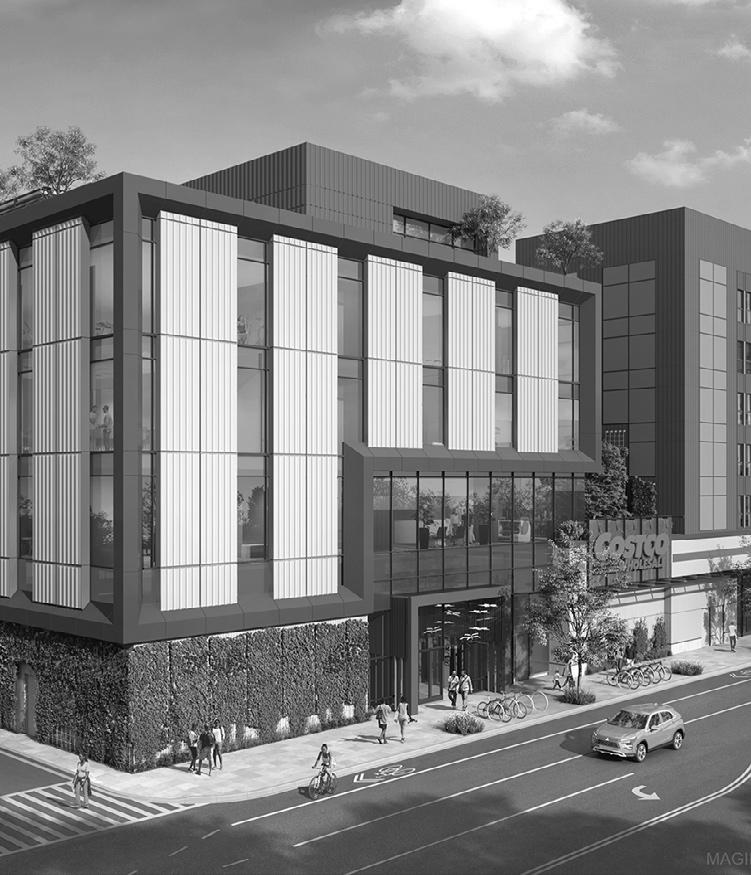

Balfour Beatty Hits Project Milestones in San Diego County

Balfour Beatty celebrated the completion of the $84.5 million Youth Transition Campus Phase 2 project. This facility replaces the former 70-yearold Juvenile Hall facilities with a modern campus that is a nationwide model for therapeutic, traumainformed and “home-like” youth rehabilitation to improve outcomes for high-risk youth in San Diego County.
Balfour Beatty has achieved major milestones on two San Diego County projects, including the groundbreaking of the East County Crisis Stabilization Unit in El Cajon, Calif., and the completion of the Youth Transition Campus Phase 2 project in Kearny Mesa, Calif.
Balfour Beatty and county of San Diego recently broke ground on the $29 million East County Crisis Stabilization Unit (CSU). The CSU is designed to provide individuals a safe space to stabilize and recover amid a behavioral health crisis in the area as well as help reduce emergency department patient loads, particularly at the nearby Sharp Grossmont Hospital, which has one of the busiest emergency rooms in the country.
see BALFOUR page 4

Four General Contractors Effecting
SR 33 Repairs After 2023 Landslide

Rapoport CEG CORRESPONDENT
Operations continue on State Route (SR) 33 to repair the damage from a January 2023 landslide, with crews from R&R Demolition and Grading Corp. and three other general contractors making solid progress in Ventura to complete the emergency repairs, according to the California Department of Transportation (Caltrans).
In April, Marc Bischoff, a Caltrans District 7 public information officer said, “Emergency repairs and traffic control will continue on State Route 33 between mile 14.35 ([near Cozy Dell Trailhead] and mile 44.13 [almost two miles north of Pine Mountain summit] in Los Padres National Forest at least through this summer.
“Approximately 32 miles of highway were closed for emergency repairs from Jan. 10 to Dec. 18, 2023, when one-lane alternating traffic control with solar-powered signals was implemented through
seven construction zones.
“Outside of those six locations, one lane is open to traffic in each direction, as is normal,” he added. “This section of SR-33 experienced extensive mudslides, rockslides, erosion and sections of collapsed roadway from extensive storms during the winter of 20222023. Additional rainstorms this past winter caused intermittent work stoppage. The one-lane alternating traffic control also slows the reconstruction process.
“There are still four retaining walls to be built and construction of the first wall at post mile 14.13 is under way. Slope and roadway repair and drainage installation continue at multiple locations. The estimated total construction cost for all repairs is $35 million.”
The contractors are Staples Construction, Union Engineering, Granite Construction and R & R Demolition and Grading.

A Caterpillar 315 hydraulic excavator helps restore a road shoulder on State Route 33.
Irwin



























































Granite Construction Lands $45M, $38M Caltrans Contracts
Granite Construction of Watsonville, Calif., was awarded an approximately $45 million contract to reconstruct and modernize the John Wilkie Safety Roadside Rest Area along the Interstate 40 corridor by the California Department of Transportation (Caltrans), the company announced in a news release.
In addition, Caltrans awarded Granite an approximately $38 million contract (Segment 4E South) to add peak-hour high occupancy vehicle lanes and reconstruct all elements of the existing Highway 101 through southern Santa Barbara, the company said in a separate release.
The rest area project marks the fifth in a series of initiatives to improve safety and infrastructure along I-40. The project scope includes constructing a modern rest area for motorists. Given the significant distance from the nearest town, this upgraded rest area will provide a safe place for travelers to rest and recover, enhancing safety along this stretch of the interstate.
Previous projects included filling in the median, flattening slopes adjacent to the roadway and creating recovery areas for vehicles that leave the highway.
including 12,200 tons of asphalt for parking lots and ramps.
The project was expected to begin in September 2024 and completed in January 2026.
The Highway 101 contract is the sixth mainline segment
101.
Mainline segments in Carpinteria and Summerland are complete, and the mainline segment south of Summerland is scheduled for completion by the end of this year. Multiple segments are under way in Montecito and are scheduled for completion in 2026. The Segment 4E South contract will fully integrate into the Montecito segments, maximizing synergies and enhancing overall project efficiency.
“We are committed to making I-40 safer for all who travel through this area. Our relationship with Caltrans has been fostered and strengthened through our continued work along the I-40 corridor.”
“We are committed to making I-40 safer for all who travel through this area,” Granite Vice President of Regional Operations Bill Moore said. “Our relationship with Caltrans has been fostered and strengthened through our continued work along the I-40 corridor, and we are excited to contribute further to this vital infrastructure.”
Granite will provide materials from Desert Cities Asphalt,
Bill Moore
Granite Construction
awarded to Granite under its Construction Manager/General Contractor (CMGC) contract. The collaborative team, including Granite, Caltrans and the Santa Barbara County Association of Governments (SBCAG), have worked together for more than five years under the contract to make improvements to Highway
In addition to improving traffic flow, this project emphasizes sustainability. Materials removed from existing facilities are recycled into aggregate base (13,000 tons). The concrete used for paving is produced from an onsite batch plant (11,800 cu. yds)., with materials sourced from Granite’s nearby aggregate facilities (19,000 tons). Hot mix asphalt will be supplied from Granite’s Gardner and Santa Paula Hot Plants (12,850 tons).
“This project is another significant step forward to relieving traffic congestion through this critical corridor,” Granite Vice President of Regional Operations Larry Camilleri said. “We are excited to work with Caltrans and SBCAG to deliver another important project for the community and traveling public.”
This segment was expected to begin in September 2024 and completed in October 2026.
A year earlier, a $48 million contract was awarded to Granite to reconstruct 10.9 mi. of Highway 101, the company said in a news release. The project is expected to be completed in June 2026.
Youth Transition Campus Phase 2 Facility Project Completed
The 14,000-sq.-ft. facility will be the first CSU in East County and will feature expanded services, 24-hour care and recliner chairs for patients to receive assessments, medication assistance and peer and individual therapy and support. The county’s newest CSU is projected to be completed in fall 2025.
Balfour Beatty also celebrated the completion of the $84.5 million Youth Transition Campus Phase 2 project. This facility replaces the former 70-year-old Juvenile Hall facilities with a modern campus that is a nationwide model for therapeutic, trauma-informed and “home-like” youth rehabilitation to improve outcomes for high-risk youth in San Diego County. The new facility features sports and recreational areas, visiting areas and various classroom settings including technical education programs. The Youth Transition Campus Phase 2 accommodates up to 72 youth in 12-bed cohorts that have individual sleeping quarters with private bathrooms, one-on-one counseling spaces, meeting rooms, a shared kitchenette and furnished common dayroom that includes televisions, books and phones. Phase 2 also provides a large garden area with fruit trees and other
seasonal plants that will provide fruits and vegetables for the facility’s developing “farm-to-table” culinary arts program.
The facility’s second phase follows Balfour Beatty’s successful completion of the award-winning Youth Transition Campus Phase 1 in January 2022 which received the Design-Build Institute of America Project/Team National Merit Award. The completion of Phase 1 and Phase 2 concludes the five-year, $193.5 million project which was contracted in 2019.
“These milestones demonstrate our commitment to being the county of San Diego’s trusted building advisor,” said Dan Ferguson, Balfour Beatty Justice and Civic director in California. “Our long-standing relationship with the county allows us to understand their vision deeply and translate it into facilities that serve the community’s evolving needs. We’re honored to play a role in improving mental health access and youth rehabilitation services in the county and we look forward to continuing our work to build a stronger, healthier San Diego.”
For more information, visit www.balfourbeattyus.com. (Photos courtesy of Balfour Beatty.)

The East County Crisis Stabilization Unit (CSU)
BALFOUR from page 1

Mixed-Use L.A. Complex to Include Costco, 800 Apartments
A new Costco planned for Los Angeles will include something not typically found at the warehouse store: apartments, according to ABC7.com.
Privately owned developer Thrive Living broke ground on Sept. 18 at a 5-acre site in the Baldwin Village neighborhood. The mixeduse complex will include a members-only warehouse store, as well as 800 apartment units above it, the website reported.
There will be 184 units set aside for lowincome tenants, according to Thrive Living. The remainder will be offered as non-subsidized affordable and workforce housing.
“5035 Coliseum is the first new housing community in Los Angeles to move forward under state law AB 2011, which helps streamline approvals for apartment and mixed-use projects that include low-income housing,” Thrive Living said in a press release.
According to its release, Thrive Living will use “a cost-effective and innovative modular design that enables the delivery of high-quality housing at below market rates’” to build the complex.
The developer said the project is the nation’s first mixed-use development with Costco as its anchor retail tenant. Construction timelines weren’t disclosed at the groundbreaking.
According to the Thrive website, the project will include secure parking, several interior courtyards, a gym, community gardens, a rooftop pool, a full basketball court and two half courts, and various climbing and play structures.
Thrive said the Costco will offer fresh produce, healthy food options, optical services, a pharmacy and delivery services to help local businesses.
Thrive and Costco “also plan to create a local hire and job training program for residents of Baldwin Village and neighboring communities. In all, Costco estimates that up to 400 new local jobs will be created,” according to the Thrive press release.
For now, the nearest Costco is in Inglewood, a 20-minute drive to the south, according to KCAL News.
(All photos courtesy of Thrive Living.)




A front view of the 5035 Coliseum project.
The ground floor of the planned Costco.
A courtyard view of the 5035 Coliseum project.
4191 Power Inn Road, Suite D Sacramento, CA 95826
916-737-7777
PIRTEK
San Leandro
1997 Burroughs Ave San Leandro, CA 94577
510-568-5000
121 S. Maple Ave #4 South San Francisco, CA 94080
650-532-9200







Los Padres National Forest Home to Landslide Work Zone
LANDSLIDE from page 1
Bischoff noted that SR-33 is “still subject to temporary full closures depending on construction needs.”
The work zone covers the area in Los Padres National Forest north of the city of Ojai. There are four emergency projects to repair damage to the highway and its slopes and embankments.
“Relentless storms from the winter of 2022/2023 caused excessive damage to a substantial portion of SR-33,” Bischoff said. “The highway experienced extensive mudslides, rockslides, erosion to slopes and embankments and several sections of collapsed roadway. Three retaining walls [set with steel piles] are under construction. Slopes and embankments are under reconstruction at multiple locations. Some embankments required the construction of Rock Slope Protection using boulders weighing up to 6 tons each and many of the boulders were recycled from the slides.
“Some include the use of geogrid, a geosynthetic material used to reinforce and stabilize the soil and provide filtration,” he added. “Some slopes require installation of elevated cable-mesh drapery systems. All guardrail within the closure has been replaced. Drains and culverts have been cleared and are also being replaced. The areas of reconstruction will be reinforced and stabilized with the intent to prevent future highway, slope and embankment failures in the same locations and maintain a safe travel route.”
Approximately 32 mi. of roadway were closed from Matilija Hot Springs Road to the Ozena Fire Station just south of Lockwood Valley Road from Jan. 10 until Dec. 18, 2023. The highway was reopened to the public that day, but emergency repairs continue and there are seven locations with one-way traffic control managed by solar-powered sig-
nals or flagging.
The traffic control, at the time, dealt with mile 14.35 (near Cozy Dell Trail), mile 22.48 (about three miles south of Rose Valley Road), miles 24.62 to 25.60 (starting about a mile south of Rose Valley Road), mile 26.34 (about ½ mile north of Rose Valley Road), mile 23.86 (just south of the chain control sign, mile 42.94 (near Pine Mountain summit) and mile 44.13 (almost 2 miles north of the summit).
“Work is expected to continue into November, although some construction locations may be completed sooner,” Bischoff said.
Caltrans has secured $35 million in emergency funding for the project.
“Damage was so extensive and varied that it had to be divided into four separate sections with four separate contractors to complete it,” Bischoff said.
Bischoff explained why the repairs were taking so long to complete.
“Members of the Caltrans Geotechnical Division had to review every section of highway in person and through drone aerial video to assess damage that continued to change and increase every time it rained,” he said. “Then the Design Division had to create plans to repair every section of damage. The Environmental Division had to work to secure permits from five different state and federal agencies.
“Well over 2,000 truckloads of debris were removed. Some sections of roadway collapsed. Reparation of slopes and embankments is a slow and dangerous process that includes rock scalers and heavy equipment traversing steep inclines. Storms during the summer of 2023 also caused additional damage.” CEG
(Photos courtesy of Caltrans.)



More Than $166M OK’d for I-680 Improvements
U.S. Sen. Alex Padilla (D-Calif.) announced that the Contra Costa Transportation Authority and the California Department of Transportation (Caltrans) will receive more than $166 million in Bipartisan Infrastructure Law funding to improve mobility along the Interstate 680 corridor.
The investments were made through the U.S. Department of Transportation’s National Infrastructure Project Assistance (Mega) Program.
The funds will go toward Contra Costa’s INNOVATE 680 Program to complete the northbound I-680 express lane gap from California State Route 24 to SR-242 and to
convert the existing northbound high-occupancy vehicle (HOV) lane from SR-242 to north of Arthur Road into an express lane.
The project also will construct a braided ramp system between the North Main Street and Treat Boulevard interchanges in Walnut Creek to address an existing bottleneck caused by weaving, implement coordinated adaptive ramp metering for a 19-mi. segment of northbound I-680 and include a Caltrans truck scale/weigh station.
“California commuters will get where they need to go faster, and we will improve connectivity across the Bay Area and San Joaquin Valley,” Padilla said. “Decongesting I-680 is
essential to preventing delays and bolstering driver safety and efficiency along this busy corridor.”
“Partnering with state and local agencies, California is using its transportation dollars to provide travelers with more options that will help us reduce planet-warming pollution, improve air quality and combat climate change,” Caltrans Director Tony Tavares said.
“The Mega Grant program funds major projects that are too large or complex for traditional funding programs and are likely to generate national or regional economic, mobility or safety benefits.
(Photo courtesy of U.S. Sen Alex Padilla.)
Work crews move extensive amounts of dirt while rebuilding the area around State Road 33.
A part of State Road 33 damaged by landslides
Sen Alex Padilla (D-Calif.)










Work Begins On $3.74B UC Davis Medical Center Project
A groundbreaking ceremony was held on July 22 in downtown Sacramento, Calif., at the UC Davis Medical Center complex as the facility kicked off a major expansion of the hospital complex.
UC Davis Health hosted the event to begin construction on its new 14-story California Tower and accompanying fivelevel pavilion to delive superior care for Northern Californians and meet the evolving needs of the greater Sacramento region, which includes the nearby city of Davis, home to the university.
“The addition of the California Tower to UC Davis Medical Center is a testament to our innovative forward thinking across our health system and main campus,” UC Davis Chancellor Gary S. May said at the groundbreaking. “This project will position our researchers, students, faculty and staff to meet and adapt to regional health care needs for the next 50 years.”
May spoke in the construction zone to an audience of university leaders, elected officials, project collaborators and construction and facilities management workers.
The massive $3.74 billion California Tower portion of the project was first approved by the UC Board of Regents in January 2022, and, when completed and
open for patients in 2030, will be part of the Sacramento region’s most advanced medical facility. The new hospital and pavilion will join the medical center’s existing University and Davis Towers.
The new tower will add nearly 1 million sq. ft. of space to the eastern side of the existing UC Davis medical complex. Among its features will be modern operating rooms, an imaging center, innovative facilities for pharmacy and burn care units, and approximately 334 private rooms for patients.
David Lubarsky, UC Davis Health’s CEO, noted that more than 250 rooms are being designed for greater flexibility in the event of a patient surge such as a pandemic, massive wildfire or other disaster.
“With the California Tower, we are building a new paradigm of patient care centered around how a health system can deliver tomorrow’s health care today,” he said.
“We are building into this new tower some of the lessons we learned from the recent pandemic. As an example, three out of four of the rooms in this new tower can be easily converted to fully functional intensive-care units if needed, tripling our ICU capacity.”
When the California Tower is open for patients, Lubarsky added, it will continue the
hospital’s 150-year legacy of “caring for those who need it most, delivering superior patient outcomes while becoming more sustainable, and keeping our focus on improving health outcomes and equity.”
Construction of the new hospital tower was done to replace parts of the medical center that must close due to California’s seismic regulations, according to UC Davis Health. Hospitals across the state are upgrading their existing facilities or constructing new buildings that can withstand major earthquakes.
The 646-bed hospital — the largest in the Sacramento area — will have 675 to 700 inpatient beds when the project is expected to finish in six years.
Tower Project to Boost Community Employment
The California Tower project also is likely to create hundreds of construction jobs and thousands of new health-care positions for the surrounding community, just one of the greater Sacramento area’s many benefits of being home to an anchor institution like UC Davis Medical Center.
Such institutions are place-based, mission-driven entities like universities and hospitals that leverage economic power along-
side human and intellectual resources to improve the long-term health and social welfare of surrounding communities, UC Davis Health noted.
“The hospital tower we’re breaking ground on today represents another pivotal investment in our city by UC Davis,” Sacramento Mayor Darrell Steinberg said.
“Both this tower and the new Aggie Square innovation campus will create thousands of new, high-quality jobs and expand our ability to meet the health care needs of our residents.”
In addition, UC Davis Health plans to help fuel the economic health and overall well-being of the neighborhoods surrounding its Sacramento campus by:
• Hiring and developing local workforce talent.
• Buying more goods and services from local vendors.
• Investing in local projects that support vulnerable communities.
• Engaging employees to volunteer in local neighborhoods.
“This project further harnesses the advantages of UC Davis Medical Center being Sacramento’s number one hospital and delivering nationally ranked care,” Lubarsky said.





























1960 Highway 20 Colusa, CA 95932 (530) 458-2166













2173 Blossom Street Dos Palos, CA 93620-2313 (209) 392-2161 600 S. State Highway 59 Merced, CA 95341-6928 (209) 383-5888
1340 W. Charter Way Stockton, CA 95206 (209) 944-5500
1215 West Glenwood Ave Turlock, CA 95380-5703 (209) 634-1777 827 North Tehama St Willows, CA 95988 (530) 934-3382
3056 Colusa Highway Yuba City, CA 95993 (530) 923-7675

